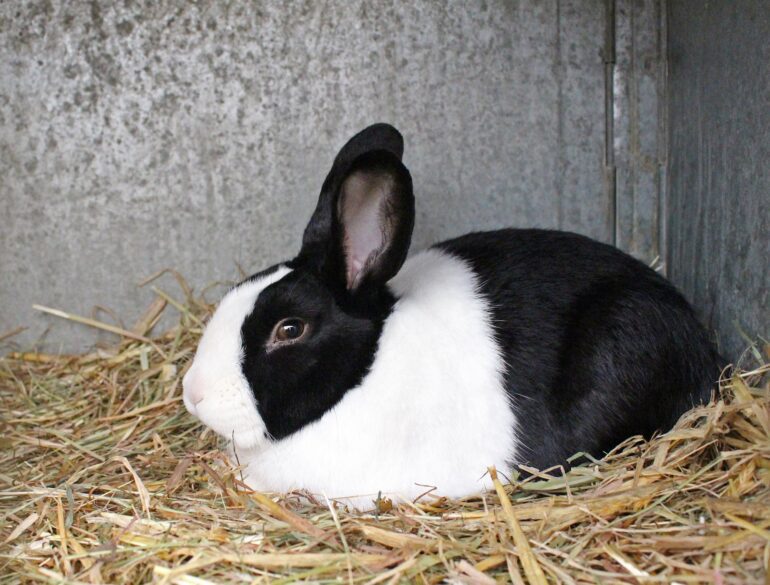Are you considering a rabbit as a new pet? Dutch rabbits make good domestic pets because they are gentle creatures that enjoy affection and only weigh three to five pounds. Their long fur coats are soft and easy to pet.
Contrary to what the name suggests, Dutch rabbits descend from Belgium Brabancon rabbits and were bred to perfection in England.
The variety of colors make these animals attractive to pet owners. The rabbits are mostly white with very precise spots of colored fur ranging from black, chinchilla, chocolate, gray, lilac, steel and tortoise.
Adoption decreased for this species after dwarf rabbits became popular, but Dutch rabbits remain among the top ten most popular breeds in the world. You can join clubs honoring their preservation and specific colors.
Do Dutch Rabbits Make Good Pets?
Dutch rabbits make great pets as well as show animals. They make ideal pets for children over the age of 10 because they are gentle, easily trained and require minimal grooming.

Kanashi on Pixabay
These furry creatures adapt well to the weather and can be kept outdoors all year round, although it is ideal to shelter them from harsh weather. If you keep your rabbit in a shed or garage, it should include light and ventilation. If you choose to keep your rabbit outside, be mindful of potential predators like stray dogs, racoons or hawks.
Maintaining an indoor living space for your rabbit is easy because they are intelligent and easily potty trained. You should clean out their cage at least once a day.
If you are considering getting a Dutch rabbit, it’s important to think about the other pets you have at home. Although Dutch rabbits are calm, they do get spooked easily. If you have a dog, cat or any other large animal, it’s possible for the rabbit to live in a constant state of fear. This could create a harsh and high-level stress environment for the rabbit, which could cause it to become shy and retreat.
Are Dutch Rabbits Friendly?
Yes. They are even-tempered, submissive and a safe option for kids. Another plus is these rabbits love lots of social interaction. Children can easily teach them tricks.
Dutch rabbits require love and affection to thrive. They get bored easily so it’s important to keep them occupied with toys. Every animal is different, so try a variety of toys until you find one your pet likes.
There are three main things to consider when purchasing a toy: flavor, texture and scent. It’s important to consider these senses because rabbits like to chew, dig and forage. A great tip to get you started is providing your rabbit with a variety of toys and keeping track of which ones they engage with more.
Common toys for rabbits include cardboard, twig balls, apple sticks and natural hay-based toys. Other alternatives can be mobile toys and hard plastic baby toys.
Some toys are never safe for any rabbits like those made of fabric, carpet, soft rubber or metal. You should avoid anything that has small pieces that could easily break off. If your rabbit swallows them it could lead to a GI tract obstruction and require a trip to the vet.
Do Dutch Rabbits Like To Be Held?
It depends. All rabbits are considered prey animals, which means they don’t like being picked up and can be frightened easily.
Another important fact to remember is that Dutch rabbits are fragile. You can fracture their bones if you handle them roughly. It’s important to supervise any child under the age of 10 when they hold the rabbit.
Luckily, you can begin to form a bond with your rabbit that will help them feel at ease while being held. You can start the bonding process by training your family members to treat them gently. If you pick up your furry friend the wrong way they will be startled.
Make your rabbit comfortable by petting them. Start with their forehead and behind the ears. Next, move on to stroking their cheeks or upper back. Do not pet their bottom, feet, chin or belly because it makes them uncomfortable.
Once they get used to the sensation of petting, you can begin to experiment with holding them. Hold your rabbit firmly but gently. Make sure that one hand supports the upper back. They will feel more secure if all four feet are against your body.
Avoid picking up your rabbit by the ears. You will injure your rabbit and cause them unnecessary stress. If you mishandle them, they are likely to lose trust in you and hide.
How Long Do Dutch Rabbits Live?
Dutch rabbits have an average life span of five to eight years, although some can live up to 10 years.
There are a few things to consider if you’d like to extend your rabbit’s lifespan. First, indoor rabbits have a longer lifespan than outdoor rabbits. On average, outdoor rabbits only have a five-year lifespan because outdoor living creates a more stressful environment for the rabbit. Harsh weather can also lower their life expectancy. A Dutch rabbit’s long fur can intensify in the summer heat, but it isn’t warm enough to protect against hypothermia in the winter.
Living outside also exposes your rabbit to predators like stray dogs, raccoons and hawks. Even if predators can’t reach your pet in its cage, the stress can lead to premature death. Outdoor rabbits are more exposed to fleas, ear mites, ticks and mosquitoes that can lead to deadly diseases.
Neutering your pet rabbit could also help to extend its life. Unspayed female rabbits have an 80% chance of developing ovarian cancer by age four. Male rabbits also run the risk of developing prostate cancer. Dutch rabbits should be neutered when they reach sexual maturity at about six months old.
A healthy diet and plenty of exercise is sure to help the lifespan of your furry friend. Rabbits thrive on a natural diet that is high in fiber, which may include one to two cups a day of grass-based hay and leafy green vegetables. Only feed your rabbit pellets sparingly because they may begin to prefer them over healthy greens. Be sure to give your pet ample play time in the morning or evening.



